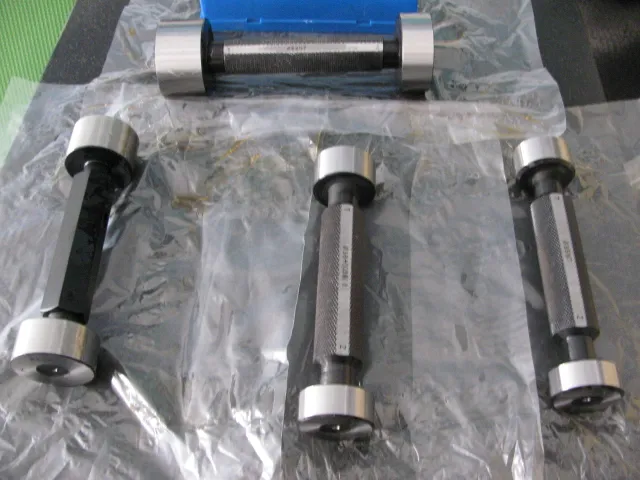يونيو . 11, 2025 14:21 الرجوع للقائمة
Small Hole Gauge Accuracy in Medical Device Production
In the highly regulated world of medical device manufacturing, precision isn’t just a goal—it’s a necessity. From surgical instruments to implantable devices, even the slightest dimensional inaccuracy can compromise patient safety, product performance, or regulatory compliance. Among the tools that ensure this precision, small hole gauges, plug gauges, and plug ring gauges play pivotal roles. This article explores how these instruments contribute to accuracy, quality, and efficiency in medical device production, while addressing common questions about their advantages and applications.

The Critical Role of Small Hole Gauges in Medical Device Manufacturing
Small hole gauges are indispensable for measuring the internal diameters of tiny bores, a common feature in devices like catheters, hypo tubes, and fluid delivery systems. These gauges operate by expanding a tapered spindle or split-ball mechanism within a hole, allowing technicians to measure dimensions with micrometer-level precision.
In medical device production, components often require holes as small as 0.1 mm in diameter. A deviation of even a few microns can affect how parts fit together or interact with biological systems. For example, an oversized hole in a drug-eluting stent could alter medication release rates, while an undersized needle bore might impede fluid flow during injections. Small hole gauges mitigate these risks by providing reliable, repeatable measurements that align with strict tolerances.
Moreover, these gauges are designed for compatibility with sterile environments. Many medical-grade small hole gauges feature corrosion-resistant materials like stainless steel or titanium, ensuring durability and preventing contamination—a critical factor in compliance with ISO 13485 and FDA standards.

Understanding Plug Gauges and Plug Ring Gauges: Tools for Precision
While small hole gauges excel at measuring variable diameters, plug gauges and plug ring gauges serve as go/no-go tools for verifying fixed hole and shaft sizes. A plug gauge typically consists of a cylindrical pin with two ends: one at the maximum acceptable dimension (the “go” side) and one at the minimum (the “no-go” side). If the “go” end fits into a hole but the “no-go” end does not, the part passes inspection.
Plug ring gauges, on the other hand, are used to assess external diameters, such as the shafts of surgical screws or connectors. Like their plug counterparts, they validate whether a component’s dimensions fall within predefined limits. Together, these tools streamline quality control processes by enabling rapid, unambiguous checks without requiring complex setups.
In medical manufacturing, plug gauges and plug ring gauges are often employed during high-volume production runs. For instance, a plug gauge might verify the inner diameter of hundreds of syringe barrels per hour, while a plug ring gauge ensures that spinal implant rods meet exact thickness specifications. Their simplicity reduces human error, making them ideal for maintaining consistency across batches.
Ensuring Accuracy: Best Practices for Using Small Hole Gauges and Plug Gauges
To maximize the accuracy of small hole gauges, plug gauges, and plug ring gauges, manufacturers must adhere to rigorous protocols:
Calibration: Regularly calibrate gauges against certified master standards to account for wear or environmental factors like temperature fluctuations.
Handling: Train technicians to avoid excessive force when inserting gauges, which can distort measurements or damage delicate components.
Material Compatibility: Select gauge materials that match the hardness of the parts being tested to prevent abrasion.
Documentation: Maintain records of calibration dates, inspection results, and maintenance activities to satisfy audits.
For small hole gauges, proper technique is especially critical. Operators must ensure the gauge is centered in the hole and gently expanded until it contacts the walls. Misalignment can lead to false readings, risking the approval of non-conforming parts. Similarly, plug gauges should be cleaned after each use to prevent debris from affecting measurements.

FAQs: Answering Your Questions on Small Hole Gauges, Plug Gauges, and Plug Ring Gauges
What Are the Advantages of Using Small Hole Gauges in Medical Device Production?
Small hole gauges offer unmatched versatility for measuring variable hole sizes, especially in hard-to-reach areas. Their adjustable design reduces the need for multiple fixed gauges, saving time and costs while ensuring precision.
How Do Plug Gauges Improve Quality Control?
Plug gauges provide instant pass/fail feedback, simplifying inspections and reducing human error. Their durability and ease of use make them ideal for high-throughput environments common in medical device manufacturing.
Why Choose Plug Ring Gauges Over Other Measuring Tools?
Plug ring gauges deliver rapid, reliable assessments of external diameters. Unlike digital calipers, they require no power or calibration during use, ensuring uninterrupted workflow in sterile production settings.
Can Small Hole Gauges Measure Non-Circular Holes?
Standard small hole gauges are designed for cylindrical holes. However, specialized versions with segmented anvils can accommodate slight irregularities, making them suitable for certain medical components with non-standard geometries.
Are Plug Gauges Compatible with Automated Inspection Systems?
Yes! Many plug gauges and small hole gauges can be integrated into automated quality control systems, enabling real-time data collection and analysis for process optimization.
In an industry where precision saves lives, small hole gauges, plug gauges, and plug ring gauges are more than tools—they’re guardians of quality. By understanding their applications, advantages, and best practices, medical device manufacturers can uphold the highest standards while streamlining production. Whether you’re verifying a microscopic catheter bore or a critical implant shaft, these instruments ensure that every dimension aligns with the exacting demands of healthcare.
-
Thread Plug Gauge Requires Careful HandlingأخبارJul.29,2025
-
Surface plate calibrationأخبارJul.29,2025
-
Ring Gauge Ensures Machining AccuracyأخبارJul.29,2025
-
Pad Iron Reinforces Anchor PointsأخبارJul.29,2025
-
Ground anchor stabilizes embankmentsأخبارJul.29,2025
-
Granite Box Maintains Precision FlatnessأخبارJul.29,2025
منتجات ذات صله









